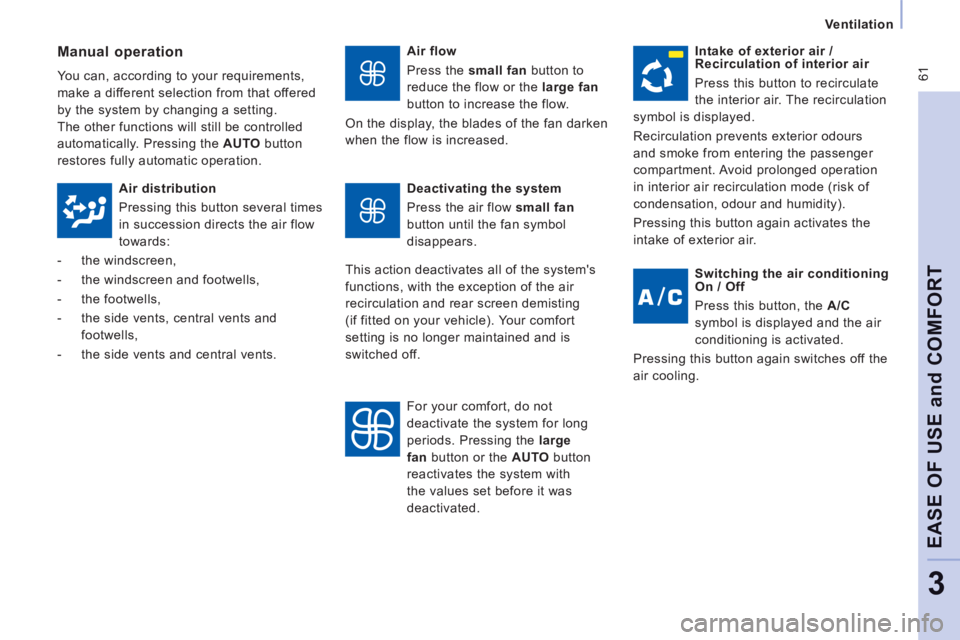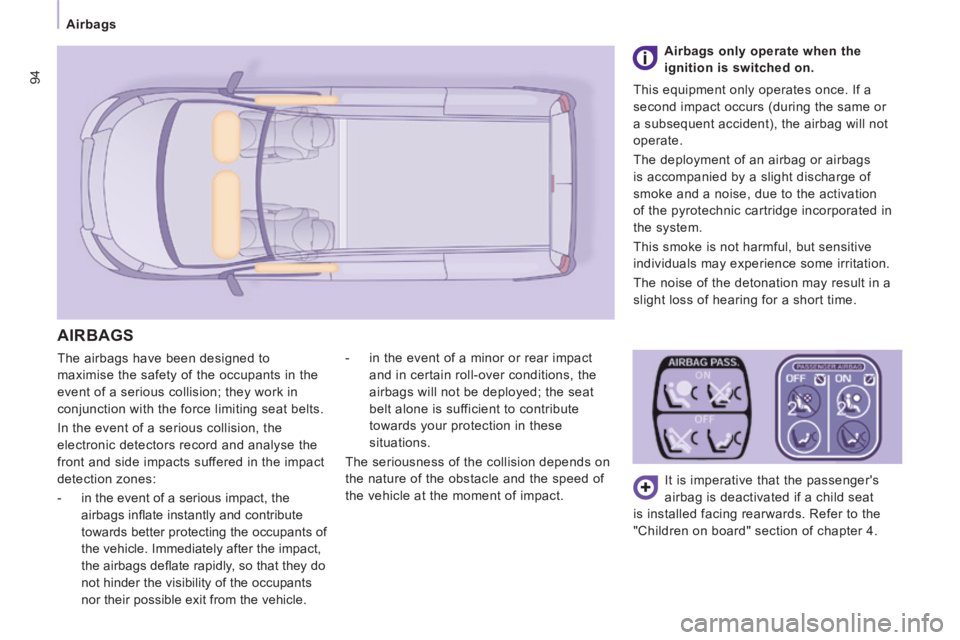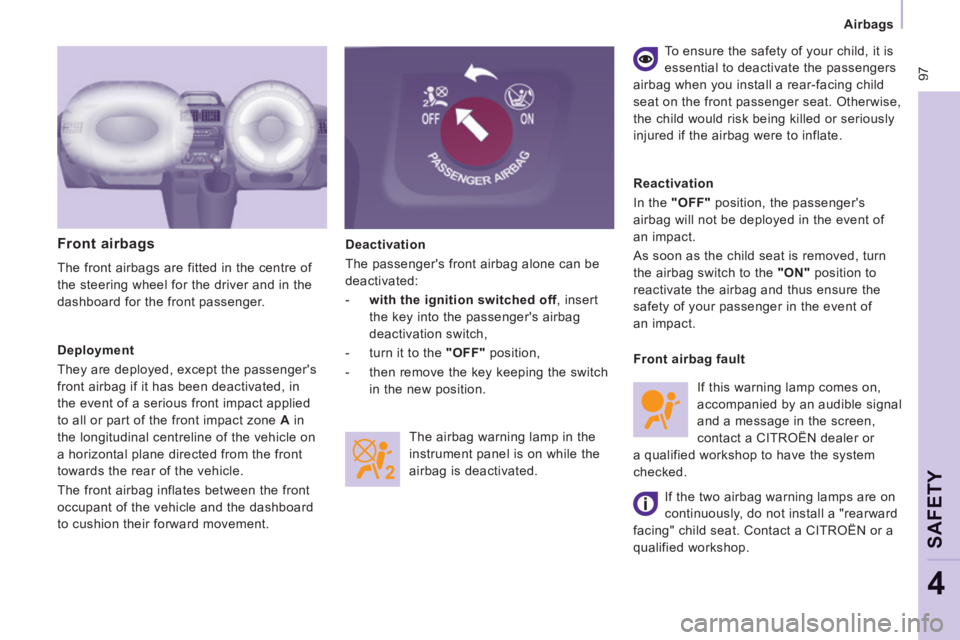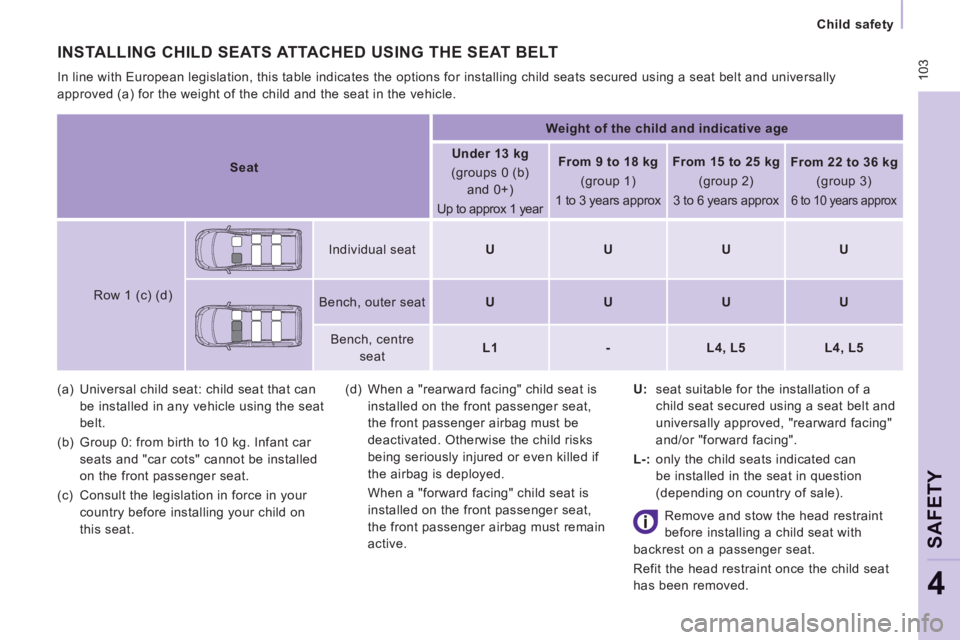tow CITROEN JUMPY 2006 User Guide
[x] Cancel search | Manufacturer: CITROEN, Model Year: 2006, Model line: JUMPY, Model: CITROEN JUMPY 2006Pages: 252, PDF Size: 12.15 MB
Page 59 of 252

57
Ventilation
EASE OF USE
and
COMFORT
3
WITH MANUAL SETTINGS
If your vehicle is fitted with these controls,
they are located on the control panel of the
dashboard centre console.
Air distribution
Air distribution is directed by turning the
control towards: the side vents and the central
vents,
the side vents, the central vents
and the footwells,
the footwells,
the windscreen and the footwells,
Air flow
The air conditioning does not operate if the
air flow is set to 0.
the windscreen.
Air conditioning A/C
If fitted on your vehicle, the air conditioning
can only operate with the engine running. Pressing the button triggers the
operation of the air conditioning,
the LED is on. Pressing the
button again switches the function
off and the LED goes off.
Temperature adjustment
Control positioned:
- in the red zone, produces heating of the interior air.
- in the blue zone, produces
cool air,
The air distribution can be
modulated by placing the control
in the intermediate positions,
marked "●". The fan speed varies from 1 to
the fastest 4. Position 0 switches
it off.
Remember to adjust this control
in order to attain the desired
comfort level.
VENTILATION
Page 63 of 252

61
Ventilation
EASE OF USE
and
COMFORT
3
Air flow
Press the small fan button to
reduce the flow or the large fan
button to increase the flow.
On the display, the blades of the fan darken
when the flow is increased. Manual operation
You can, according to your requirements,
make a different selection from that offered
by the system by changing a setting.
The other functions will still be controlled
automatically. Pressing the AUTO button
restores fully automatic operation. Intake of exterior air /
Recirculation of interior air
Press this button to recirculate
the interior air. The recirculation
symbol is displayed.
Recirculation prevents exterior odours
and smoke from entering the passenger
compartment. Avoid prolonged operation
in interior air recirculation mode (risk of
condensation, odour and humidity).
Pressing this button again activates the
intake of exterior air.
Air distribution
Pressing this button several times
in succession directs the air flow
towards:
- the windscreen,
- the windscreen and footwells,
- the footwells,
- the side vents, central vents and footwells,
- the side vents and central vents. Deactivating the system
Press the air flow
small fan
button until the fan symbol
disappears.
This action deactivates all of the system's
functions, with the exception of the air
recirculation and rear screen demisting
(if fitted on your vehicle). Your comfort
setting is no longer maintained and is
switched off.
For your comfort, do not
deactivate the system for long
periods. Pressing the large
fan button or the AUTO button
reactivates the system with
the values set before it was
deactivated. Switching the air conditioning
On / Off
Press this button, the
A/C
symbol is displayed and the air
conditioning is activated.
Pressing this button again switches off the
air cooling.
Page 64 of 252

62
Ventilation
CORRECT USE OF THE VENTILATION AND AIR CONDITIONING
Passenger compartment filter,
carbon filter
Ensure that this fi lter is in good condition and
have all of the fi lter elements replaced regularly.
Vents
"Leave them open"
For optimum distribution and diffusion of hot
or cool air in the passenger compartment,
there are adjustable central and side vents
which can be directed sideways (right or
left) towards the top of the body. For your
comfort while driving, do not close them,
direct the flow of air towards the windows
instead.
The air vents directed towards the floor of
the vehicle complete the equipment.
Refer to the "Checks" section of
chapter 6.
Air conditioning
In all seasons, the air conditioning should
only be used with the windows closed.
However, if the interior temperature remains
high after a prolonged period parked
in the sun, first ventilate the passenger
compartment for a few minutes. Use the AUTO mode as much as
possible as it permits optimised control
of all of the functions: air flow, passenger
compartment comfort temperature,
air distribution, air intake mode or air
recirculation in the passenger compartment.
Operate the air conditioning system for 5 to
10 minutes, once or twice a month, to keep
it in perfect working order.
It is normal that the condensation created by
the air conditioning system results in a flow
of water which may form a puddle under the
vehicle when parked.
If the system does not produce cold air, do
not use it and contact a CITROËN dealer or
a qualified workshop.
Page 79 of 252

77
Practical information
EASE OF USE
and
COMFORT
3
LOAD SPACE FITTINGS
Depending on the vehicle's equipment, the
various fittings below enhance your load
space.
Locations for lashing rails
Locations for fitting a lashing rail are
available on each side of the vehicle.
Lashing rings
Use the lashing rings on the rear floor to
secure your loads.
As a safety precaution in case of sharp
braking, you are advised to place heavy
objects as far forwards towards the cab as
possible.
You are advised to immobilise the load by
securing it firmly using the lashing rings on
the floor.
Trims
The lower parts of the sides are fitted with
load protection trims.
Roof box on raised version
This is a storage compartment located in the
load space, above the cab roof.
Page 87 of 252

85
Driving safely
SAFETY
4
PARKING BRAKE There is no advantage in engaging a gear after parking
the vehicle, particularly if the vehicle is loaded. HAZARD WARNING LAMPS
Press this button, the direction indicators
flash.
They can operate with the ignition off.
The hazard warning lamps should only be
used in dangerous situations, when stopping
in an emergency or when driving in unusual
conditions.
DRIVING SAFELY
Applying
Pull the parking brake lever up to immobilise
your vehicle.
Check that the parking brake is applied
firmly before leaving the vehicle.
If the parking brake is still on or has not been
released properly, this is indicated by this warning
lamp which comes on on the instrument panel.
Pull on the parking brake lever, only with
the vehicle stationary .
In the exceptional case of use of the parking
brake when the vehicle is moving, apply the
brake by pulling gently to avoid locking the
rear wheels (risk of skidding).
When parking on a slope, direct your wheels
towards the pavement and pull the parking
brake lever up.
Releasing
Pull the lever and press the button to lower
the parking brake lever.
Page 88 of 252

86
Parking sensors
Engage reverse gear
An audible signal confirms the activation of
the system by engaging reverse gear.
The proximity information is indicated by an
audible signal which becomes more rapid as
the vehicle approaches the obstacle. When
the distance between the rear of the vehicle
and the obstacle is less than approximately
thirty centimetres, the audible signal
becomes continuous.
Stop the assistance
Change to neutral.
REAR PARKING SENSORS
The audible and/or visual rear parking
sensor system consists of four proximity
sensors, installed in the rear bumper. The
sensors detect any obstacle which enters
the field: person, vehicle, tree, fence, behind
the vehicle during the manoeuvre.
Certain objects detected at the beginning of
the manoeuvre will no longer be detected
at the end of the manoeuvre due to the
blind spots between and below the sensors.
Examples: stake, roadworks cone or
pavement post.
Activation / Deactivation
You can activate or deactivate the
system by pressing this button.
The activation or deactivation of
the system is stored when the
vehicle stops.
Malfunction
In the event of a malfunction, when reverse
gear is engaged the LED in the button
comes on, accompanied by an audible
signal and a message in the screen. Contact
a CITROËN dealer or a qualified workshop.
Good practice
In bad weather or in winter, ensure that the
sensors are not covered with mud, ice or
snow.
The system will be deactivated automatically
if a trailer is being towed or if a bicycle
carrier is fitted (vehicle fitted with a
towbar or bicycle carrier recommended by
CITROËN).
The parking assistance cannot, in any
circumstances, take the place of the
vigilance and responsibility of the driver.
Display in the screen
You are advised to deactivate the system if
your vehicle is fitted with a rear ladder or if
you are transporting a load which exceeds
the length of the vehicle.
Page 96 of 252

94
Airbags
The airbags have been designed to
maximise the safety of the occupants in the
event of a serious collision; they work in
conjunction with the force limiting seat belts.
In the event of a serious collision, the
electronic detectors record and analyse the
front and side impacts suffered in the impact
detection zones:
- in the event of a serious impact, the airbags infl ate instantly and contribute
towards better protecting the occupants of
the vehicle. Immediately after the impact,
the airbags defl ate rapidly, so that they do
not hinder the visibility of the occupants
nor their possible exit from the vehicle. - in the event of a minor or rear impact
and in certain roll-over conditions, the
airbags will not be deployed; the seat
belt alone is sufficient to contribute
towards your protection in these
situations.
The seriousness of the collision depends on
the nature of the obstacle and the speed of
the vehicle at the moment of impact. It is imperative that the passenger's
airbag is deactivated if a child seat
is installed facing rearwards. Refer to the
"Children on board" section of chapter 4. Airbags only operate when the
ignition is switched on.
AIRBAGS
This equipment only operates once. If a
second impact occurs (during the same or
a subsequent accident), the airbag will not
operate.
The deployment of an airbag or airbags
is accompanied by a slight discharge of
smoke and a noise, due to the activation
of the pyrotechnic cartridge incorporated in
the system.
This smoke is not harmful, but sensitive
individuals may experience some irritation.
The noise of the detonation may result in a
slight loss of hearing for a short time.
Page 98 of 252

96
Airbags If this warning lamp comes
on in the instrument panel,
accompanied by an audible signal
and a message in the screen,
contact a CITROËN dealer or
a qualified workshop to have the system
checked. The airbags may no longer be
deployed in the event of a serious impact.
Lateral airbags
If fitted on your vehicle, this is a system
which protects the driver and front
passenger in the event of a serious side
impact in order to limit the risk of injury to
the chest.
Each lateral airbag is fitted in the front seat
back frame, on the door side. Impact detection zones
A. Front impact zone.
B. Side impact zone.
In the event of a minor impact or bump
on the side of the vehicle or if the
vehicle rolls over, the airbag may not be
deployed.
The airbag is not deployed in the event of a
rear or front collision. Operating fault
Deployment
It is deployed unilaterally in the event of a
serious side impact applied to all or part
of the side impact zone B , perpendicular
to the longitudinal centreline of the vehicle
on a horizontal plane and directed from the
outside towards the inside of the vehicle.
The lateral airbag inflates between the
front occupant of the vehicle and the
corresponding door trim panel.
Page 99 of 252

97
Airbags
SAFETY
4
Deactivation
The passenger's front airbag alone can be
deactivated:
- with the ignition switched off , insert the key into the passenger's airbag
deactivation switch,
- turn it to the "OFF" position,
- then remove the key keeping the switch in the new position. Front airbags
The front airbags are fitted in the centre of
the steering wheel for the driver and in the
dashboard for the front passenger. Reactivation
In the
"OFF" position, the passenger's
airbag will not be deployed in the event of
an impact.
As soon as the child seat is removed, turn
the airbag switch to the "ON" position to
reactivate the airbag and thus ensure the
safety of your passenger in the event of
an impact. To ensure the safety of your child, it is
essential to deactivate the passengers
airbag when you install a rear-facing child
seat on the front passenger seat. Otherwise,
the child would risk being killed or seriously
injured if the airbag were to inflate.
The airbag warning lamp in the
instrument panel is on while the
airbag is deactivated.
Deployment
They are deployed, except the passenger's
front airbag if it has been deactivated, in
the event of a serious front impact applied
to all or part of the front impact zone
A in
the longitudinal centreline of the vehicle on
a horizontal plane directed from the front
towards the rear of the vehicle.
The front airbag inflates between the front
occupant of the vehicle and the dashboard
to cushion their forward movement. If this warning lamp comes on,
accompanied by an audible signal
and a message in the screen,
contact a CITROËN dealer or
a qualified workshop to have the system
checked. Front airbag fault
If the two airbag warning lamps are on
continuously, do not install a "rearward
facing" child seat. Contact a CITROËN or a
qualified workshop.
Page 105 of 252

103
Child safety
SAFETY
4
(a) Universal child seat: child seat that can be installed in any vehicle using the seat
belt.
(b) Group 0: from birth to 10 kg. Infant car seats and "car cots" cannot be installed
on the front passenger seat.
(c) Consult the legislation in force in your country before installing your child on
this seat.
INSTALLING CHILD SEATS ATTACHED USING THE SEAT BELT
In line with European legislation, this table indicates the options for \
installing child seats secured using a seat belt and universally
approved (a) for the weight of the child and the seat in the vehicle.
Seat Weight of the child and indicative age
Under 13 kg
(groups 0 (b) and 0+)
Up to approx 1 year From 9 to 18 kg
(group 1)
1 to 3 years approx From 15 to 25 kg
(group 2)
3 to 6 years approx From 22 to 36 kg
(group 3)
6 to 10 years approx
Row 1 (c) (d) Individual seat
U U U U
Bench, outer seat U U U U
Bench, centre seat L1
- L4, L5 L4, L5
(d) When a "rearward facing" child seat is installed on the front passenger seat,
the front passenger airbag must be
deactivated. Otherwise the child risks
being seriously injured or even killed if
the airbag is deployed.
When a "forward facing" child seat is installed on the front passenger seat,
the front passenger airbag must remain
active. Remove and stow the head restraint
before installing a child seat with
backrest on a passenger seat.
Refit the head restraint once the child seat
has been removed. U: seat suitable for the installation of a child seat secured using a seat belt and
universally approved, "rearward facing"
and/or "forward facing".
L-: only the child seats indicated can be installed in the seat in question
(depending on country of sale).